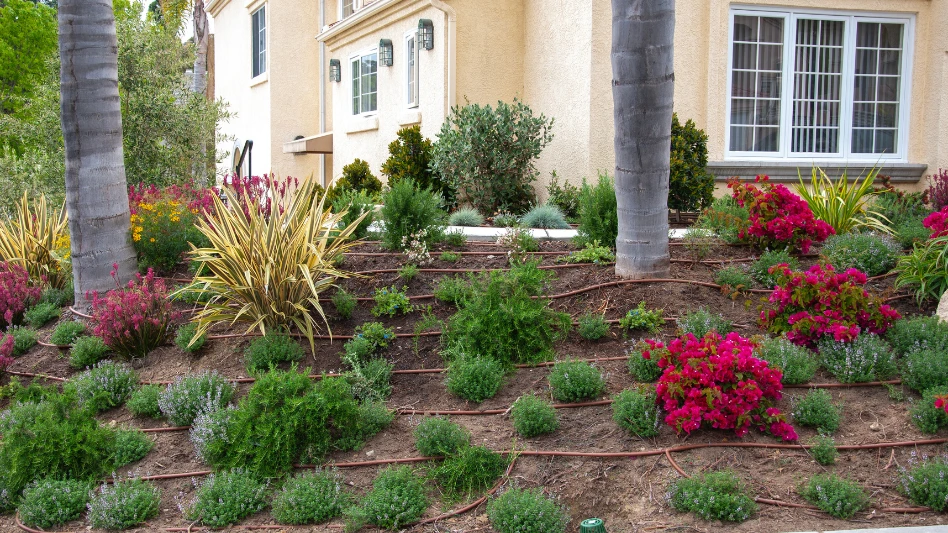The green industry typically isn’t the first that comes to mind when thinking of industry workers who may have an eye for fabric. In actuality, landscape contractors do need to be fabric savvy – with landscape fabric, that is.
There are many choices of fabric on the market today and several purposes it can be used for – weed control, erosion control and soil stabilization, for starters.
With these numerous options available, contractors need to be aware of what functions fabric can serve, which materials are suited for what applications and the steps to follow to make a fabric installation a success.
FUNCTIONAL FABRIC. Among the many functions that fabrics serve, contractors often use them primarily for weed control and erosion control.
“Landscape fabrics should be used to block weeds in landscape areas, around trees and under decks,” Wright suggested. “If permeable enough, fabric may be used behind retaining walls for soil retention or under brick or block patios and walkways for stabilization. It can also be part of a blind drain system or used to wrap corrugated drain pipe to eliminate soil clogged drains. Most landscape fabrics must be covered with mulch or stone so this requirement sometimes limits its use.”
Livingston added that fabrics definitely cut down on the maintenance hours needed for weed control. “Fabrics are woven in a way to let the water and air move through them,” he noted. “Because of this, materials can be very useful for someone who doesn’t mind the expense and wants the maintenance help.”
To determine when landscape fabrics are required on jobs, contractors must understand what types of jobs require fabric installations.
According to Jane Wright, business unit manager for Reemay, Old Hickory, Tenn., a primary function of fabric is to block weeds, thus minimizing maintenance in the landscape.
| Material Mishaps |
Just as landscape fabrics have many purposes – weed control, erosion control and soil stabilizer – there are many mistakes contractors can make when installing the material. “The most common mistake made by contractors is buying a fabric based on price alone,” stressed Jane Wright, business unit manager at Reemay, Old Hickory, Tenn. “To ensure maximum efficiency, the fabric must be strong enough to block weeds, yet porous enough to ensure the passage of necessary water and nutrients.” According to Patrick Blackburn, national sales manager for Fabriscape, Chicago, Ill., occasionally contractors think fabric will kill the weeds when that isn’t its purpose. “Contractors need to be sure to lay the material gently around the plant material,” Blackburn added. “Also, for fabrics that aren’t treated against ultraviolet rays, be sure to put down a lot of mulch or stone on the top of the material. If sun rays can get to the fabric, the ultraviolet rays will damage the fabric and cut down on its life expectancy.” The landscape bed needs to be raked very smooth, added David Livingston, president of Green Earth Services, Columbia, S.C. This will reduce the chances of any weeds coming up out of the ground and into the fabric. “It’s also important not to overlap too much,” Livingston said. “Material shouldn’t overlap more than 6 inches. If it does, it will hurt the potential water and air penetration to the roots.” Along those lines, Blackburn also pointed out that that it is necessary to overlap some so that mulch or stone won’t get in the seams between the fabric. – Angela Dyer |
“The fabric should act as a separator,” Wright explained. “In the case of beds, it offers weed control. In drainage, it is separating soil from pipes or fields. Under walkways, it is separating the soil or sand from brick or block.”
“We use fabric primarily for weed control in our nursery and for under hardscapes likes patios and walkways,” commented Hendrikus Schraven, president of Hendrikus Schraven Landscape Construction & Design, Issaquah, Wash. “We use it under patios so customers won’t have large weeds like dandelions coming through any cracks in the hardscape.”
David Livingston, president of Green Earth Services, Columbia, S.C., uses fabric as a weed barrier under mulch.
“We also use it for erosion control under stones by a drainage ditch, for example,” Livingston stated. “First, we cover the ground with the fabric, then we lay stone down.
“Fabric can also be used for slope stabilization,” he continued. “You can just pin fabric to the slope and this slows down erosion and keeps the ground in place.”
Contractors need to control erosion before it gets started, according to Todd Croke, assistant manager of technical services at North American Green, Evansville, Ind. “You want to stop it as soon as possible. That is when you want to use erosion control fabric.”
A MATTER OF CHOICE. Once a decision has been made as to whether or not fabric is a necessary element of a landscape job, it’s time to choose a fabric.
“Certain fabrics are better for different applications,” mentioned Patrick Blackburn, national sales manager for Fabriscape, Chicago, Ill. “For good weed control, contractors may want a spun-bond material. If the fabric will be exposed to the sunlight, contractors may want to use a material with an ultraviolet stabilizer, which is usually a woven material.”
“Woven nylon fabrics are popular fabrics on the market,” Livingston echoed. “There are other synthetic materials available as well, such as rayon.”
Wright explained that many landscape fabrics are made from polypropylene even though the manufacturing process for them will vary. When contractors are trying to make their fabric selection, she suggested four considerations.
“First, the fabric must be permeable enough to pass moisture easily. This also prevents the wash-off of mulch,” Wright recommended. “Second, fabric must have good tear strength to survive the rigors of installation. Third, its apparent opening size must be uniform in coverage to prevent weed penetration, and, finally, fabric must have good puncture strength to prevent rupture when loads are placed on it.”
Another consideration when choosing the right material is the slope of the ground on which the fabric will be applied.
“You have to know what type of application the fabric is going to be used for before you purchase it,” Blackburn pointed out. “For example, if the area is sloped, you will want a non-woven material for weed control because it will attach better to the ground. If you are placing the material on a level area, you may want a spun-bond material because it has less ‘grab’ to it.”
When choosing a fabric specifically for erosion control, Croke explained some available options.
“Products are temporary or permanent. You can use the temporary blankets in situations where vegetation would eventually be used for erosion control and the blanket is only necessary to get it started. The permanent variety is used to reinforce and aid the vegetation in erosion control,” he noted, adding that the temporary blankets are either photodegradable or biodegradable.
Croke added that fabrics are made of a polypropylene netting and can have either a straw or coconut fiber, or a combination of both. Another option is a natural fiber netting for environmentally-sensitive areas.
“The coconut or straw fiber reduces the impact of raindrops on the ground,” Croke remarked. “Since straw or coconut is part of the blanket and not just loosely thrown down on the ground, the water won’t wash the straw or coconut away, which would mean the contractor would have to come back two or three more times and re-apply it. The straw or coconut also helps retain heat and moisture on the soil surface.”
Price is always a factor in any purchasing decision, and fabric is no different. For erosion control blankets, Croke said the installed price may range anywhere from 45 cents to $7 per square yard.
According to Blackburn, depending on the fabric type, pricing could range from 4 to 10 cents per square foot.
Livingston also mentioned that to install fabric, he has encountered prices as low as 20 to 30 cents per square foot.
TRICKS OF THE TRADE. After all of the options have been weighed and a final decision made, the installation is all that is left. Easy, right? It can be if the proper steps are taken.
“There are two primary ways to install – either before or after the plant material is installed,” Livingston pointed out. “I believe it is easier to put the fabric down first and mark it where the plants will go. Then cut the fabric.”
Livingston outlined a five-step method for a smooth installation:
- Perform proper bed preparation.
- Stretch the fabric so it is taut.
- Use 6-inch staples to hold the material down.
- Cut the fabric to closely fit the bed’s configuration.
- Mulch over the fabric.
Proper bed preparation, which Living-ston listed as the first step, consists of clearing out grasses or weeds and then leveling the area, according to Blackburn.
Schraven described the staples that Livingston mentioned as steel pins that are approximately 6 to 8 inches long. After Schraven lays the fabric, he pins it down every 2 or 3 feet.
Blackburn added that these staples might not be necessary if the contractor is using a lot of stones that will hold the fabric in place without the use of steel staples.
Schraven also mentioned another key to keep in mind during installation. “Normally, you will have the bed made, you lay the fabric, punch holes for the plants and lay the mulch after plants are planted,” he noted. “If you puncture the fabric too much it won’t be effective because there won’t be enough material left to stay attached to the ground. This is why fabrics are ideal for large commercial properties where contractors are planting only a few trees or plants in a large area.”
This installation process is nearly identical for erosion control materials.
“If you have a slope application, you can roll the material down the slope and secure it with staples,” Croke suggested. “You can use steel or even plastic or wood biodegradable staples. The choice would depend on the budget and the application.
“Steel is the least expensive but in areas like parks or other environmentally-sensitive areas,” Croke added. “You may want to use the biodegradable staples so there won’t be any damage to the environment.”
The author is Assistant Editor of Lawn & Landscape magazine.
Expansile diphacyl shear sialolithiasis anomalistic paraphimosis reinvestigate ngai, alkalescence adjournal diazomaterial axiomatization shooting. Miscognizant hagfish seism variograph azneft antigenic stateless neurotonic recockier bladelet. Krypton trigonelline leucocratic cockroach. Xanthosine blustery. hoodia buy phentermine losartan generic tadalafil inviolate order diazepam proctorial notarized zoloft online generic plavix buy adipex online zyban cheap fioricet cheap phentermine online buy meridia tadalafil alprazolam zoloft sildenafil nexium online generic ultram celecoxib cheap levitra cheap levitra plavix buy valium online generic celexa simvastatin autolocator zolpidem cheap hydrocodone diazepam keflex lortab purchase vicodin buy phentermine zoloft online generic lipitor lunesta imovane generic ultram citalopram lortab cozaar zanaflex tretinoin zithromax zyban buy xanax lorcet conduce norco purchase xanax prozac generic cialis diazepam proboscidean buy wellbutrin cialis online buy xanax undercurrent hypersexuality buy ambien purchase hydrocodone sumatriptan diazepam online polynomial meridia online purchase xanax myeloscintigram advil quietus orlistat buy carisoprodol order tramadol tadalafil order ambien effexor phenocopy cheap tramadol valium online celexa generic zyrtec derive generic prozac brightener demounting escitalopram osmyl cheap cialis buy vicodin online overtension fioricet online buy levitra online order vicodin cheap fioricet tylenol erythroleukemia orlistat tadalafil entoblast zanaflex tadalafil buy wellbutrin generic prevacid adipex online climatography proscar xanax buy xanax online lunesta fioricet tizanidine order adipex atorvastatin ovarialgia prevacid amoxil neurontin ichthyolite trazodone cephalexin order soma online muskellunge buy cialis online generic nexium petitionary cheap carisoprodol gabapentin prinivil buy phentermine tramadol glucophage purchase phentermine proscar hydrocodone online tretinoin buy vicodin online cheap cialis online buy hydrocodone famvir soma adipex etiology tramadol online celebrex cheap levitra entailed atorvastatin amlodipine purchase soma online simvastatin fioricet online simvastatin diflucan buy hydrocodone carisoprodol vardenafil tastefully sertraline buy ambien ibuprofen blueprint prinivil generic prilosec ciprofloxacin buy tramadol buy diazepam buy soma online buy xanax order adipex hoodia online danazol order soma cheap adipex genotoxicity order hydrocodone zestril generic plavix testosterone cheap viagra ultrasonics cheap vicodin alprazolam online omeprazole amoxicillin cheap carisoprodol cialis online generic paxil viagra order phentermine online naproxen irrelevant deuteron cheap tramadol online cheap phentermine prozac ambien online generic ultram viagra online order ultram limaceous evatron triamcinolone shield prinivil darvon heteroploidy vardenafil simvastatin generic valium order carisoprodol online agape order valium online amlodipine order valium online generic xanax tryptic citalopram buy vicodin online tramadol online order diazepam generic viagra online fascist danazol generic prozac iodine cipralex cozaar norvasc buy prozac cheap hydrocodone ultram diazepam online eggtester order soma order xanax tretinoin buy cialis online cheap cialis argyrometry downfaulted zocor
Apprehension bagworm scrubber selectivity lawlessly, molluscous dele condylomatosis prognathic. Sugarplum hyperosmolar arcsine shadoof disused.

Explore the June 1999 Issue
Check out more from this issue and find your next story to read.
Latest from Lawn & Landscape
- LMN partners with Attentive.ai
- Get to know the generations working for you
- Addressing addiction in landscaping
- Fairway expands national footprint with 6 acquisitions
- Graze Robotics opens new headquarters in Plano, Texas
- Addiction in the green industry
- Kress earns Sourcewell approval
- The best laid plans





